Fabulous Fiction Firsts #605

A best-seller in Europe, the first foreign-language romance novel to be translated and published in the U.S, All In* by Swedish author Simona Ahrnstedt is "sexy, smart, and completely unputdownable." (Tessa Dare)
David Hammer, the upstart, infamous venture capitalist and corporate raider, known for his brutal take-overs is poised to pull off the biggest deal in the history of Swedish finance, make it world-wide finance. His sight is set on Investum - one of Sweden's biggest and oldest financial institutions, owned and controlled by the De la Grip Family. After years of planning, all the players are in place; he needs just one member of the owning family on his side—Natalia De la Grip. He invites her to lunch.
(Countess) Natalia is everything David despises - upper-class, traditional, as close to royalty as you could get without actually being royal and yet he finds her brilliant, driven to succeed in a man’s world, and enchanting. Natalia is intrigued by this way-too handsome man who is rich, dangerous, and in the business circles - utterly unethical. However, the powerful chemistry between them leaves both of them exhilarated and vulnerable.
As the deal goes through, it turns out that it is not all about business. Past history, family secrets and revenge will force David and Natalia to confront their innermost fears and desires as they make deeply difficult choices.
“The author’s ability to skillfully fuse a luxurious lifestyle, a refreshingly different Swedish setting, a plot riddled with revenge and financial intrigue, and plenty of steamy romance means All In will be the must-have leisure read everywhere this summer.” (Booklist).
For fans of the glitz-and-glam novels of Judith Krantz, Beatriz Williams, and perhaps Sylvia Day.
* = starred review
Review: Michigan Shakespeare Festival's The Killer Angels

One thing you’ll inevitably think about while watching the Michigan stage premiere production of Karen Tarjan’s The Killer Angels – presented by Michigan Shakespeare Festival, and inspired by the 1975 Pulitzer Prize-winning Civil War novel of the same name by Michael Shaara – is how 19th century American warfare and military strategy look nothing like our contemporary conflicts; yet even so, brutality, death, and nightmarish confusion on the battlefield remain constants.
Focused on the three-day Battle of Gettysburg – cited by many as a key turning point for the victorious (uh, spoiler alert?) Union Army – Killer Angels introduces us to military leaders as well as infantrymen on both sides of the war.
How? By double- and triple-casting the production’s 12 actors. And while this casting instruction/suggestion is wholly practical, it nonetheless makes following the play’s already-complicated narrative that much harder. Indeed, if your knowledge of the Battle of Gettysburg is minimal - ahem - you’ll likely be struggling to keep the characters (and other details) straight.
But there’s also a larger storytelling paradox at work: a military battle must, by definition, involve lots of people; and yet, to establish an emotional connection to the story, the audience must have sustained, intimate access to a smaller group of characters. (This is how we follow Shakespeare’s history plays, which tend to focus less on a single battle and more on those vying for power.) Because so many leaders and soldiers played a key role – some for better, some for worse – in the Battle of Gettysburg, Killer Angels shifts focus often, providing only cursory glimpses of most characters.
Yes, some conversations among the men are highly personal and touching; but the moments are fleeting, making the show feel more like a well-crafted, visually sumptuous 3D history lesson – with occasional musical interludes.
Indeed, the cast’s spare, haunting, men's chorus harmonies on songs like the show’s opener, “The Battle Hymn of the Republic” – marvelously led by Killer Angels’ Troubadour Ian Geers – were among my favorite moments of the show. Music director Kate Hopgood, who researched and arranged the show’s music, in addition to being the show's sound designer, affectingly gives the show some soulful scaffolding (and thus gives patrons a few goosebumps).
Jeromy Hopgood’s scenic design is simple and theatrical, so that despite the play’s many locales, the only constants are a wood platform at stage right that stands in for General Lee’s (Tobin Hissong) headquarters, and a draped sheet of white fabric for projections (designed by Christine Franzen) that hangs upstage left. To establish other settings, crates get moved and stacked, so soldiers may appear to be sitting in a tree, or taking cover behind the terrain’s natural features.
Costume designer Patty Branam expertly dresses the actors in historically accurate uniforms, using a pants-and-white-shirt base that allows for several quick costume changes; and the attention paid to details like the worn, weathered look of Lee’s hat, and the way the number of buttons on a uniform indicates one's military rank, really seals the deal. Betty Thomas designed the show’s era-appropriate props, and David Allen Stoughton’s lighting design looks gauzy and occasionally spooky under cover of fog, giving Killer Angels the feel of a lived ghost story.
David Blixt does fantastic work choreographing the show’s battles, but the most arresting moment comes at the show’s climax, when an elegant and devastating bit of stagecraft conveys how Lee’s advancing Confederate troops are gutted in the final showdown.
Scenes like this, as well as the more personal, philosophical conversations that happen between men at Gettysburg, get to the heart of The Killer Angels, and director Janice L. Blixt seizes on the show’s best moments with a sure hand. And although the ensemble was strong generally, some standouts included Geers, who guides the audience through the complex story while slipping into multiple roles; Dwight Tolar as Union Col. Chamberlain, a thoughtful, dignified former schoolteacher-turned-soldier who has to make terrifying choices on the battlefield (like charging when his men run out of ammunition); Robert McLean as frustrated Confederate Lt. General Longstreet, who carries out Lee’s orders even when he knows the mission is doomed; and Hissong, who makes Lee a well-intentioned leader who’s so set on ending the war that his judgment about how to best achieve that is compromised.
Civil War buffs will likely swoon at The Killer Angels, as will fans of Shaara’s book (or the film adaptation, Gettysburg); and MSF’s overall execution is impressive and solid. But history dilettantes looking to get lost in a gripping story may instead just feel generally lost.
Jenn McKee is a former staff arts reporter for The Ann Arbor News, where she primarily covered theater and film events, and also wrote general features and occasional articles on books and music.
The Killer Angels continues through Sunday, August 14 at The Village Theater at Cherry Hill, 50400 Cherry Hill Road, Canton, MI. For tickets, visit http://www.michiganshakespearefestival.com/.
Preview: The Importance of Being Earnest, Brass Tacks Ensemble
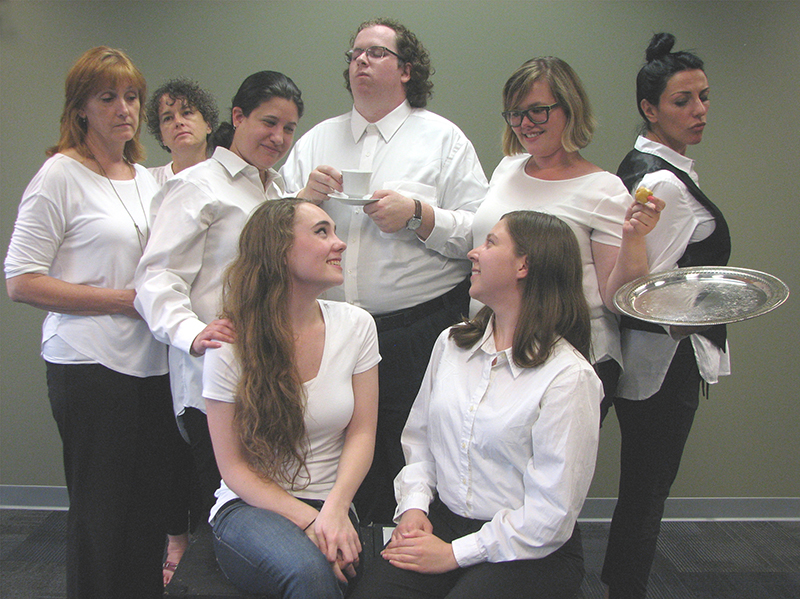
You love the intimacy of Kerrytown Concert House as a music venue. You enjoy KCH jazz, classical, cabaret, and other concerts. But did you know that this historic Ann Arbor performance space offers live theater?
The Brass Tacks Ensemble has faithfully used the Concert House as a summer venue for their outstanding mix of classical plays and original theatre since 2004 (with their staging of Shakespeare Variations, an original production of sketches based on Shakespearian tragedies). Formed when local actor and writer James Ingagiola gathered with other theatre lovers to produce King Lear at the Performance Network in 1999, Brass Tacks has consistently offered intimate and involving theatrical experiences to the Ann Arbor community.
The simplicity of the Concert House works well for the Ensemble: a guiding Brass Tacks principle is to concentrate on a play’s core elements –plot, theme, characterization - stripping away any excess and focusing on the theatrical essentials. This simple and direct approach also frees the audience’s imagination.
The Ensemble returns to Kerrytown this week, staging one of the wittiest, funniest plays in the English language: Oscar Wilde’s classic The Importance of Being Earnest. This tale of gentleman John Worthing, his love for the lady Gwendolen Fairfax, and her steadfast determination to only marry a man named Ernest combines sparkling wit, social satire, and farcical situations in one glorious package.
Directed by Ingagiola (the Ensemble’s Artistic Director), this production features local actors Amanda Barnett, Ethan Gibney, Elizaveta McFall, Amanda Photenhauer, Jan Romans, Annaliese Romans, Elizabeth Wagner, and Catherine Zudak.
If you are wondering about this largely female cast for a show that historically features five men, Ingagiola will tell you that "The sex of the characters has not changed. A lot of talented actresses are frequently left out of productions because of a dearth of female roles. They haven't been left out now."
Enjoy an evening of delightfully intimate theatre with one of the area’s most established and innovative theatrical troupes in one of Ann Arbor’s most beloved performance venues.
Tim Grimes is manager of Community Relations & Marketing at the Ann Arbor District Library and co-founder of Redbud Productions.
The Importance of Being Earnest runs Thursday - Saturday, August 4 -6, at Kerrytown Concert House, 415 North Fourth Avenue in Ann Arbor. Shows are at 8pm with an additional 2:00 pm matinee on Saturday August 6. For reservations and ticket information, call the Kerrytown Concert House at 734-769-2999 or visit http://kerrytownconcerthouse.com.
Review: "Real American" at the Ann Arbor Art Center

The Ann Arbor Art Center’s latest 117 Gallery offering asks a tantalizing, if not also impossible question to satisfactorily answer: Who—and what—is a real American?
Indeed, more precisely: What physical, cultural, theological, and/or social features does a real American have? Do these perimeters have any boundaries that pertain to being a “real” American? And what are the political consequences—if there are any such consequences—attached to this definition?
After all, the presumption is (and it’s certainly been repeated enough during this present election cycle) that there is such a thing as a “real” American. And it’s a seemingly strong potion upon which to mount a political campaign.
But is there such a thing as a real American? This display of superlative art intends to find out—for better or worse.
As juror and Ann Arbor-based photojournalist Peter Baker tells us of his rationale for the exhibit, “Real American” seeks to “explore the generational, ethnographic, cultural, and anthropological ideals of what the word ‘American’ means. From fresh apple pie to Budweiser, the Star Spangled Banner to Party in the USA, what is the modern American experience?
“Are we entering the sci-fi World of Tomorrow, longing for the Norman Rockwell past, or painting ourselves into an Idiocracy? If our culture is our biggest export, what kind of image are we presenting to the world?
“This exhibition,” concludes Baker “seeks artworks that span the spectrum from whimsical to austere, nostalgic to provocative. Artworks may consist of images from popular and visual culture, contain everyday objects assembled in unexpected ways, or incorporate stars and stripes.”
Correctly said—and perhaps the best thing about Baker’s selections in this show is the extraordinary range of what a real American can be. After all, even if the common understanding is also obviously a caricature, Americans cannot by definition or description be said to be analogous to what a Frenchman or Irishman or Nigerian supposedly looks like—or supposedly is. The beauty of the term is that a real American can look like all stereotypes.
Local, regional, and national artists selected for inclusion by Baker are Jim Aho, Mark Bleshenski, Tina Blondell, CJ Breil, Sarah Buddendeck, Seder Burns, Barbara Melnik Carson, Vanessa Compton, Errol Daniels, Keith Downie, Dan Farnum, Kathie Foley-Meyer, Heather Freeman, Jonathan Frey, David Gardner, Sarah Hahn, Amber Harrison, Christian Helser, Timothy Householder, Melissa Lynn, Astrid Muller-Karger, Dietmar Krumrey, C.B. Murphy, John Posa, Shawn Quinlan, Jim Rehlin, Jaye Schlesinger, Geoffrey Stein, Marilynn Thomas, Seth Trent, Tamara Wasserman, Chad Yenney, and Micah Zavacky.
Baker’s Best of Show selection in the exhibition is Pittsburgh, PA resident Shawn Quinlan’s quilt and fiber “The New American Heritage.” Second Place is Tulsa, OK photographer Dan Farnum’s archival inkjet color photograph “Monster Energy, Tulsa.” Third Place is Ann Arbor John Posa’s untitled acrylic on canvas mixed-media deer hide and scrap metal Donald Trump portrait. And Honorable Mentions have been handed to Minneapolis, MN’s Tina Blondell for her oil on canvas “Antimony as Nubia” and Denver, CO’s Melissa Lynn for her “Mitchelen BigMan—Crow Indian/Iraq Veteran” chromogenic color photograph print.
As stated above—and is the case with most group exhibits—there’s no particular rhyme nor reason to the artwork in “Real American” outside of taking general aim at the topic. And interestingly enough, this speaks of both the pluralism of our society as it does these artists’ decidedly independent frame of mind. The exhibit proves it’s a good American place to be.
For example, Shawn Quinlan’s Best of Show quilt and fiber “The New American Heritage” is an emphatic satirical take on what is real about being a “Real American” as the quilt takes scatological aim at the U.S.A. through its lampooning of our society’s strengths and weaknesses. Uncle Sam is depicted as a red, white, and blue clown with straw hat atop and arms propped with disembodied six-shooters at waist-height standing in front of a cloud of newspaper smoke and fire. Add an exceptionally buff George Washington as well as a vaguely surreal exquisite corpse Abraham Lincoln charbroiling a steak and Quinlan’s “The New American Heritage” is a rather pungent view of what it means to be a “Real American.”
“The New American Heritage” is one of many artworks in this exhibit that have an overt political or social bent—this is the kind of display that brings out the best of this kind of parody. Yet license of free thought is only one aspect of what it means to be an American. On the other hand, Baker’s Second Place archival inkjet “Monster Energy, Tulsa” by Dan Farnum touches far more subtly and thoughtfully at class and economics in its artless depiction of an everyday group of archetypical American youths standing casually in front of suburban strip mall.
But so much for politics: The exhibit is also exceedingly lyrical, and my favorite work on display is Allen Park, MI Seder Burns’ magnificent archival inkjet “RV Camped for the Night on BLM Land in Colorado” color photograph that describes an “unexpected, quirky, and complex” view of what it means to be a real American.
This lone camper vehicle, taking advantage of federal regulation that allows for extended free camping (albeit in a band of states running vertically from Montana to New Mexico; horizontally west to the Pacific Ocean) is shown after dusk set against a magnificent American countryside with stars and stripes strategically draped across the front windshield.
Burns’ photograph clearly partakes of what it means to be a “real” American as there’s a free-spiritedness that’s been part of our national wanderlust reaching back for centuries from the days of Native American habitation up and down North America to varied European-based explorations through the Manifest Destiny that’s subsequently championed continental expansion. His “RV Camped for the Night” merely gives this notion a well-deserved 21st century spin.
Shawn Quinlan, Dan Farnum, and Seder Burns ultimately span the range of what Baker heartily illustrates in this exhibit. Yet there are, of course, many more views. What’s implicitly inferred in each work in this display is the belief that what it means to be a “real” American is really no more than a psychological state of mind—and everything else proceeds from there.
John Carlos Cantú has written on our community's visual arts in a number of different periodicals.
“Real American” will continue through August 13 at the Ann Arbor Art Center 117 Gallery, 117 W. Liberty St. Exhibit hours are 10 am to 7 pm, Monday-Friday; 10 am to 6 pm, Saturday; and noon to 5 pm, Sunday. For information, call (734) 994-8004.
Ann Arbor Art Fair 2016: Photo Gallery
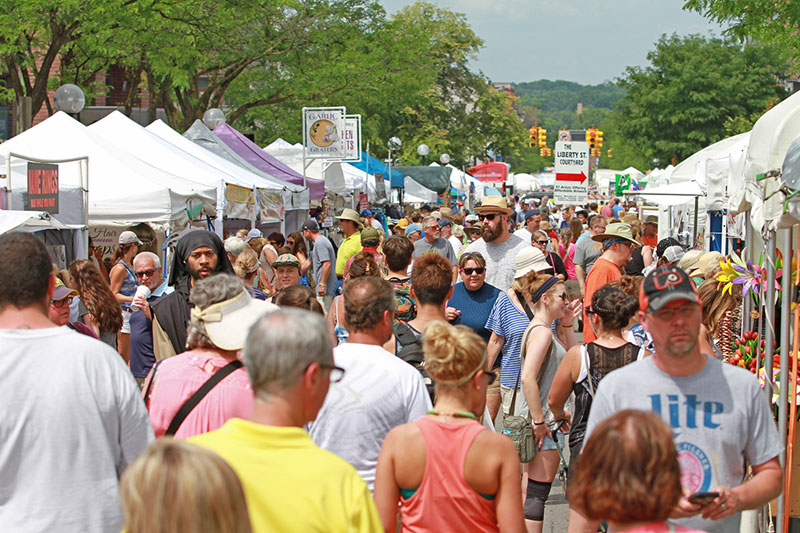
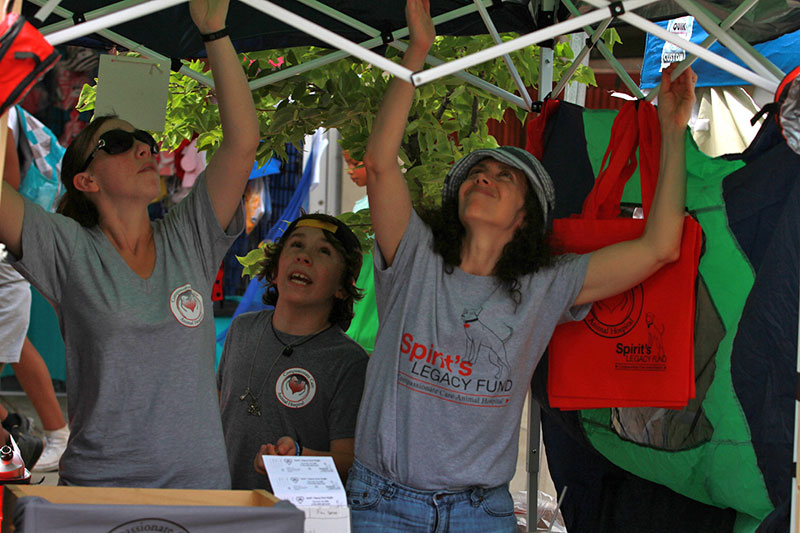
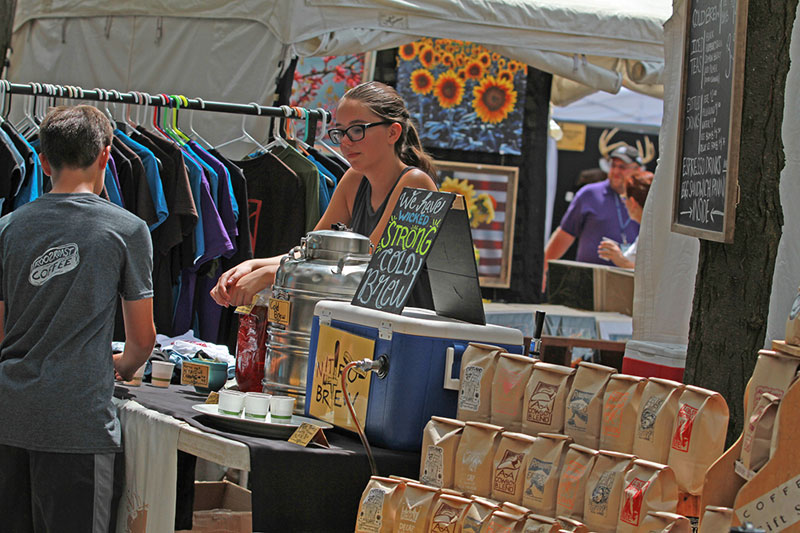
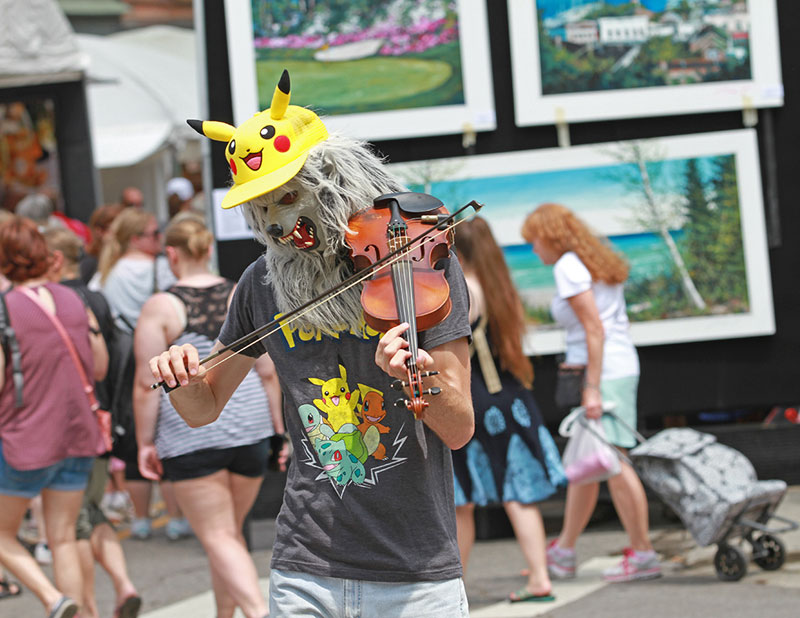
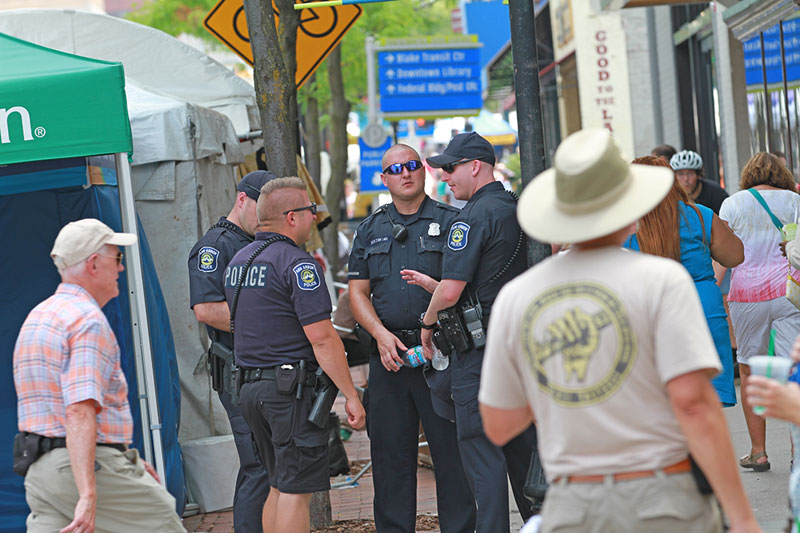
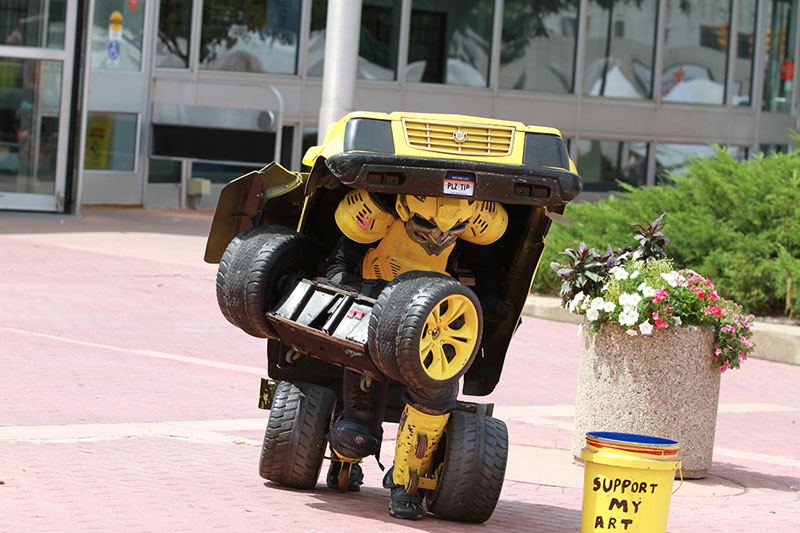

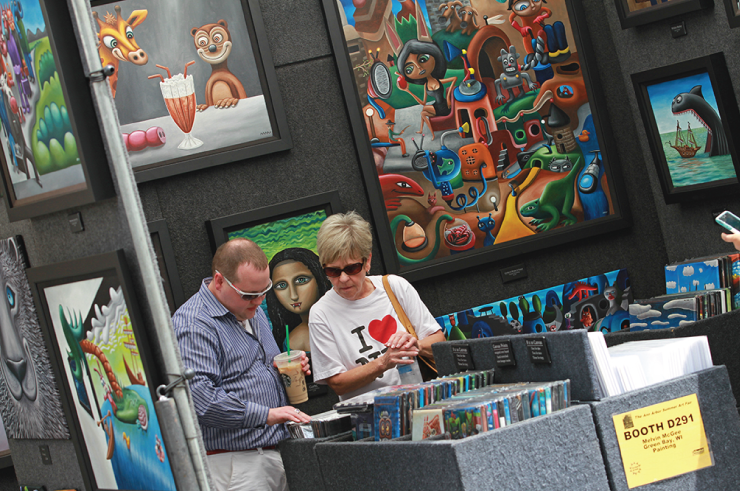
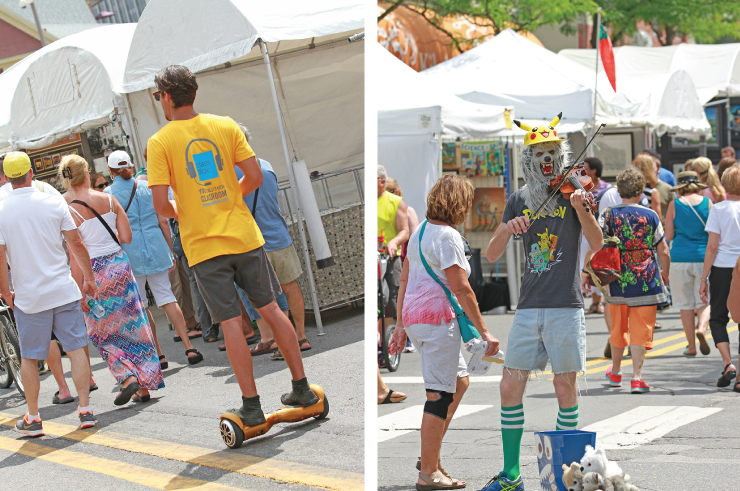

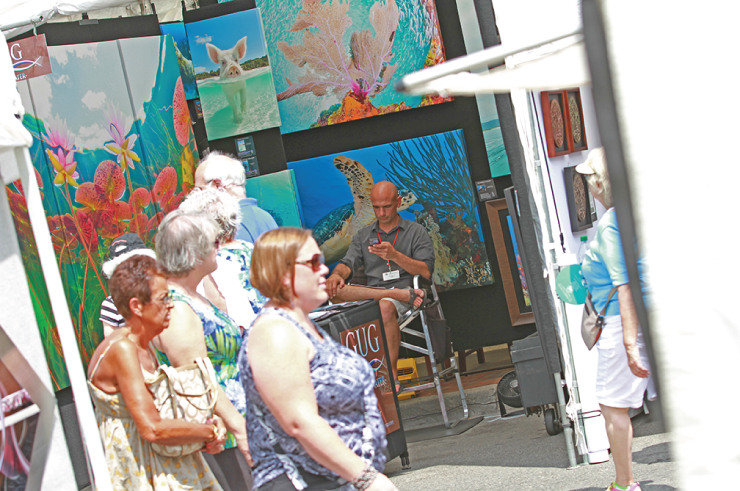
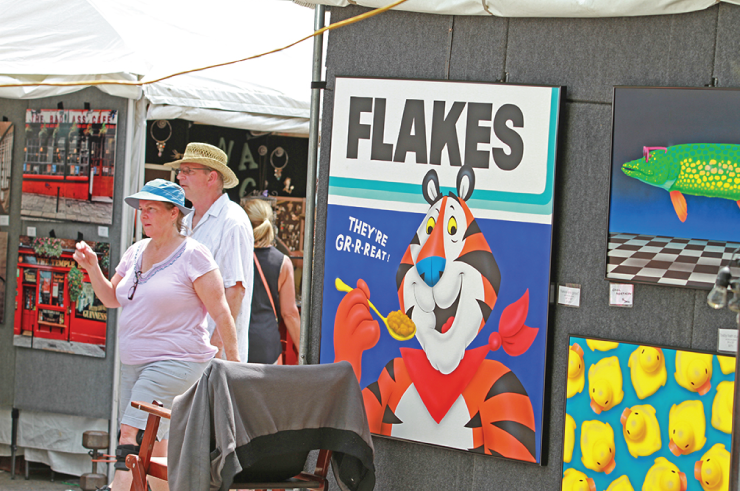
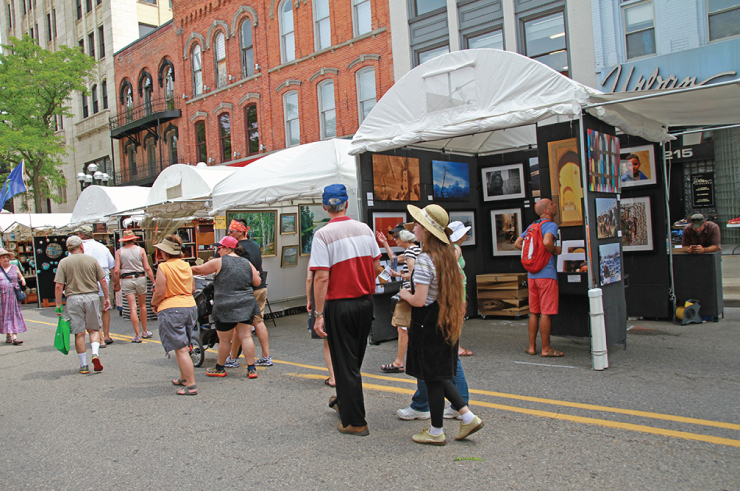
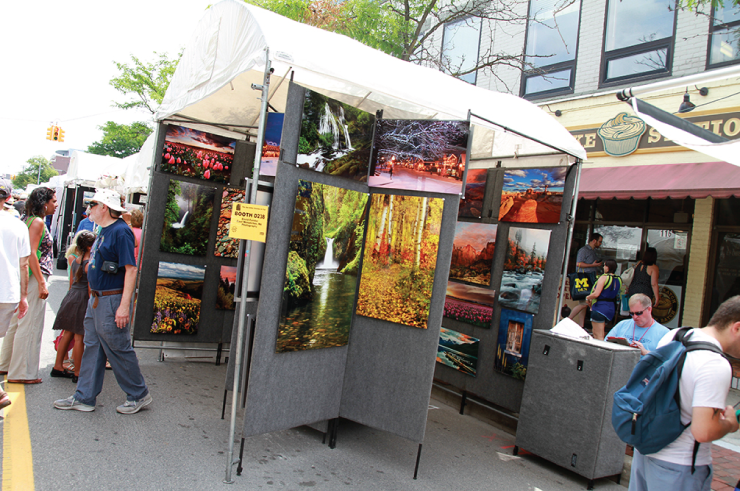
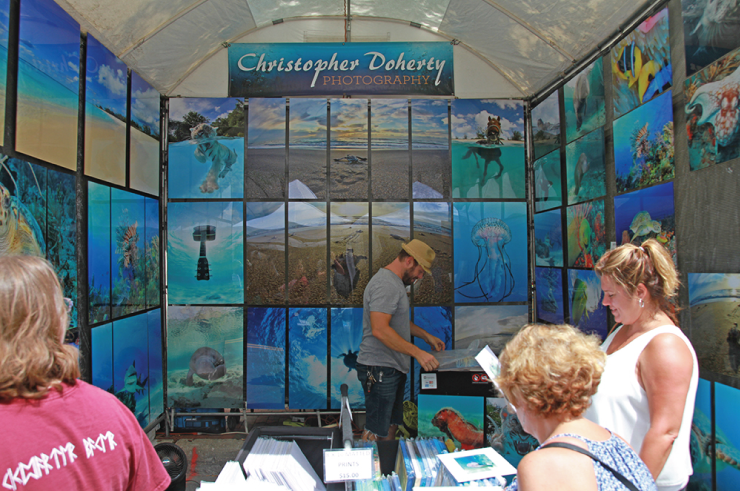
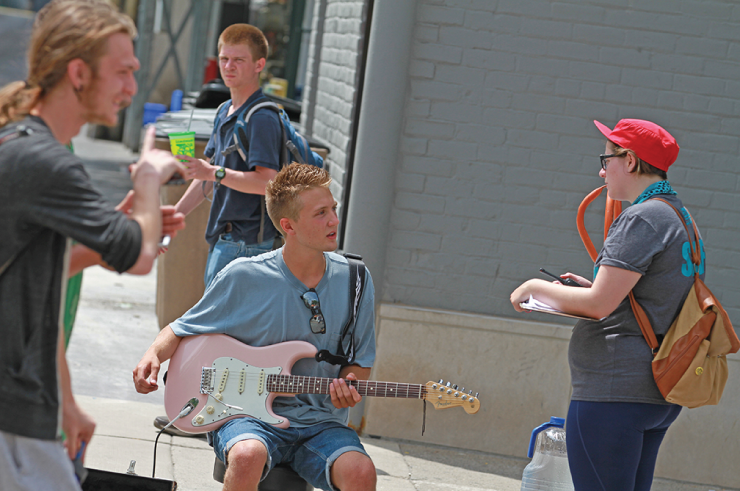
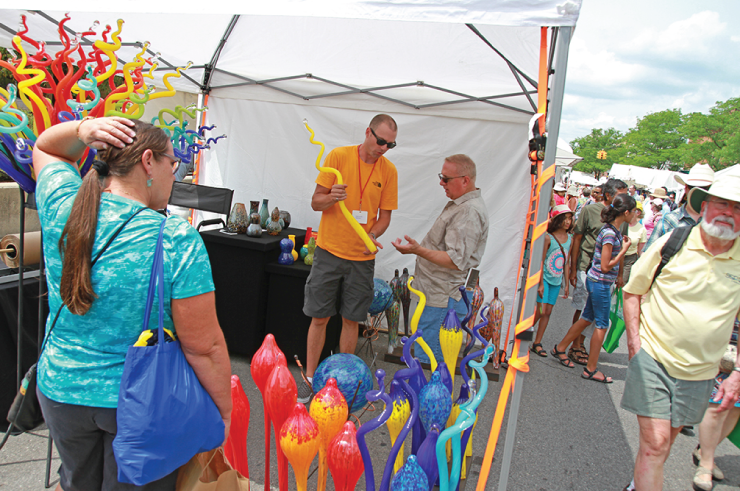
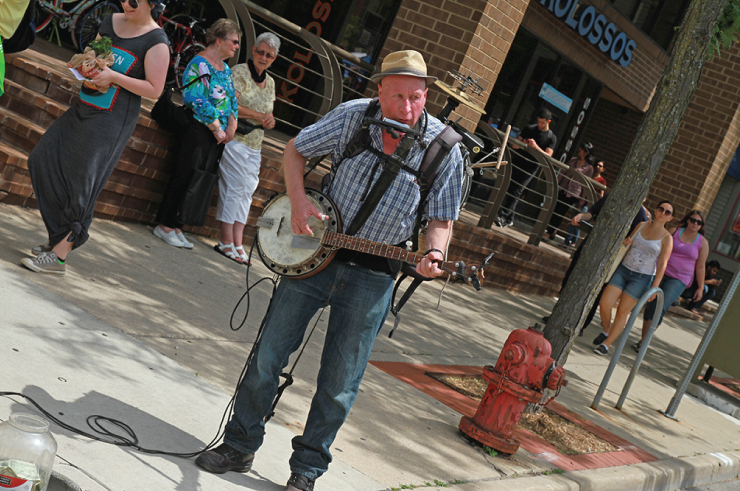
The Ann Arbor Art Fair is an annual event. The 2016 Art Fair was Thursday, July 21 through Sunday, July 24, 2016. Check their website for information and announcements for next year's festivities.
Preview: Marcia Ball at the Ark
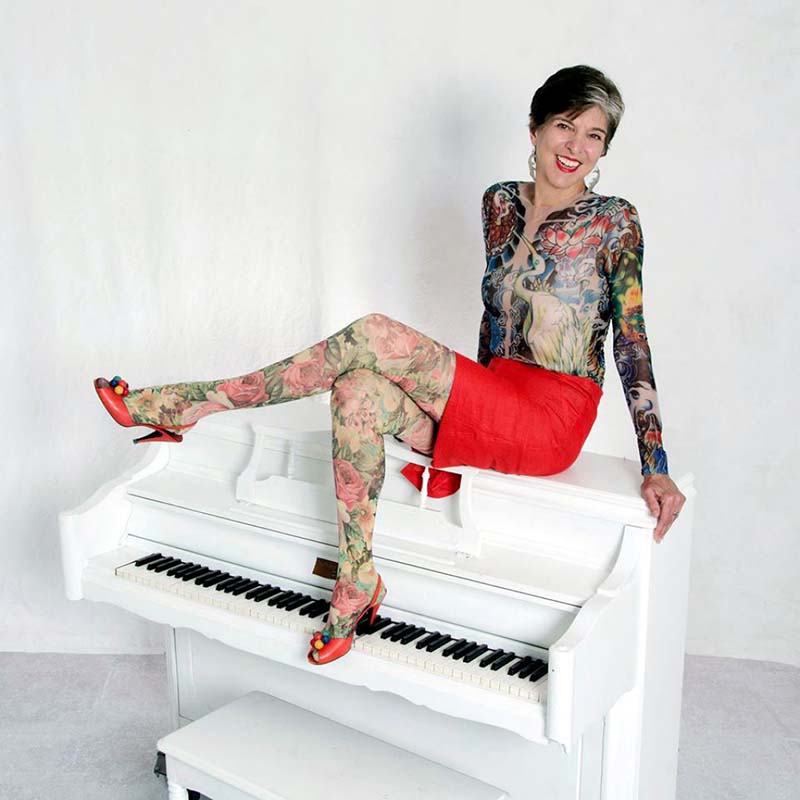
Marcia Ball, described as the “one of a kind queen of swamp blues piano,” will swing through Ann Arbor this coming Sunday, July 31 to perform what’s sure to be a rollicking show at The Ark.
Ball grew up in Louisiana in a musical family—all the women in her family including her mother and grandmother were avid piano players—and has been playing piano herself since elementary school. She played in various bands throughout the 1960s and 1970s and set out on her solo career in 1974. Heavily influenced by her Louisiana roots, Ball’s unique piano style includes elements of zydeco and boogie woogie, as well as good old southern blues.
Ball has released almost twenty records since 1972, most recently The Tattooed Lady & The Alligator Man in 2014 and has won nine Blues Music Awards. During her long career, Ball has amassed a following of devoted fans as she travels about playing venues around the country similar in size to The Ark. Ball lives in Austin, Texas now, a home she came to inadvertently in 1970. While embarking on a planned move to San Francisco, her car broke down in Austin and she enjoyed the place so much that she decided to stay.
One of the things that fans enjoy most about Ball is the vivid storytelling that punctuates her music. The song "The Tattooed Lady & The Alligator Man" is the story of finding love at a traveling carnival that’s outrageous and fun but hits home with insightful truths and witty turns of phrase. Although her shows are full of energy, Ball delivers slower, sometimes heart-wrenching tunes too, such as “Let the Tears Roll Down,” off her album Presumed Innocent which includes the lyrics “Let the tears roll down/Let my poor heart break/But you won’t hear a sound/As you walk away.” Her husky voice does particularly well expressing the pain in such songs.
Concert attendees afraid of being driven too far down a melancholy hole shouldn’t be deterred, though: she counters sorrowful ballads with songs like “Peace, Love & BBQ,” which is a song simply about hanging in the backyard grilling meat and “Let Me Play With Your Poodle,” a raunchy song with barely veiled innuendos. Fans can hope for a variety of songs this Sunday at the show; with her most recent album a few years back, Ball has been playing a mix of old and new on tour of late.
Even if your typical musical preferences don’t encompass Ball’s unusual mixture of Louisiana sound, it’s undeniable that Sunday’s show is an amazing chance to hear a truly unique brand of piano playing, performed with true Americana spirit. All hail the queen of swamp blues piano!
Elizabeth Pearce is a Library Technician at the Ann Arbor District Library. She loves blues piano, as well as hanging in the backyard grilling meat.
Marcia Ball will perform at The Ark at 7:30 pm Sunday, July 31. Tickets are $30 and doors are at 7:00pm.
Midwestern Gothic Seeking Entries for the 2016 Lake Prize

The literary journal Midwestern Gothic is accepting submissions for the 2016 Lake Prize. It's an annual literary prize for fiction and poetry that best represents the Midwest. The goal of the prize is to further the Midwestern Gothic mission of showcasing Midwestern writers and their work.
Submissions will be open from July 1 to August 31, 2016. There is a $5 flat rate entry fee - one entry per person (one short story or a group of up to 3 poems.) One winner will be selected for each category, and they will receive $300 and publication in Midwestern Gothic's Winter 2017 issue. One runner-up will be selected for both categories, and they will each receive $100 as well as publication in the Winter 2017 issue. Writers and their respective submissions should demonstrate a strong connection to the Midwest.
Sara Wedell is a Production Librarian at the Ann Arbor District Library.
More details about the Lake Prize can be found at the Midwestern Gothic website.
Art Fair Sketchbook: Karin Wagner Coron
Ever wondered what the Ann Arbor Art Fair is like from the artists' perspective? We asked Karin Wagner Coron who was set up in booth A307 on North University Ave. to give us her view – in sketches:
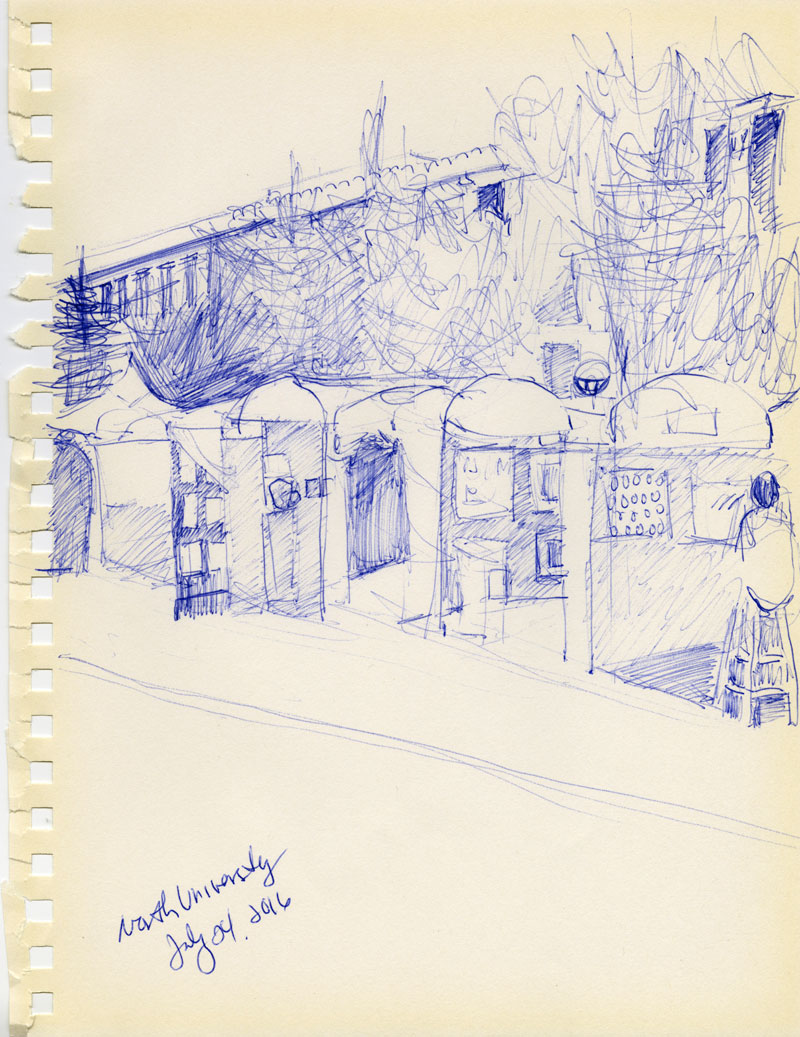
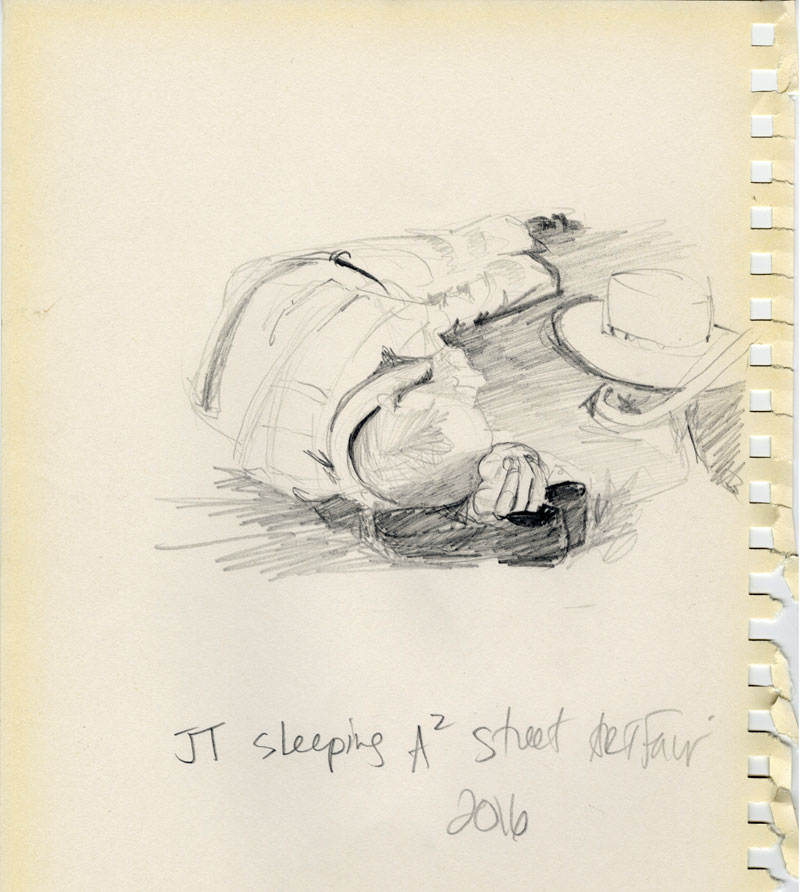
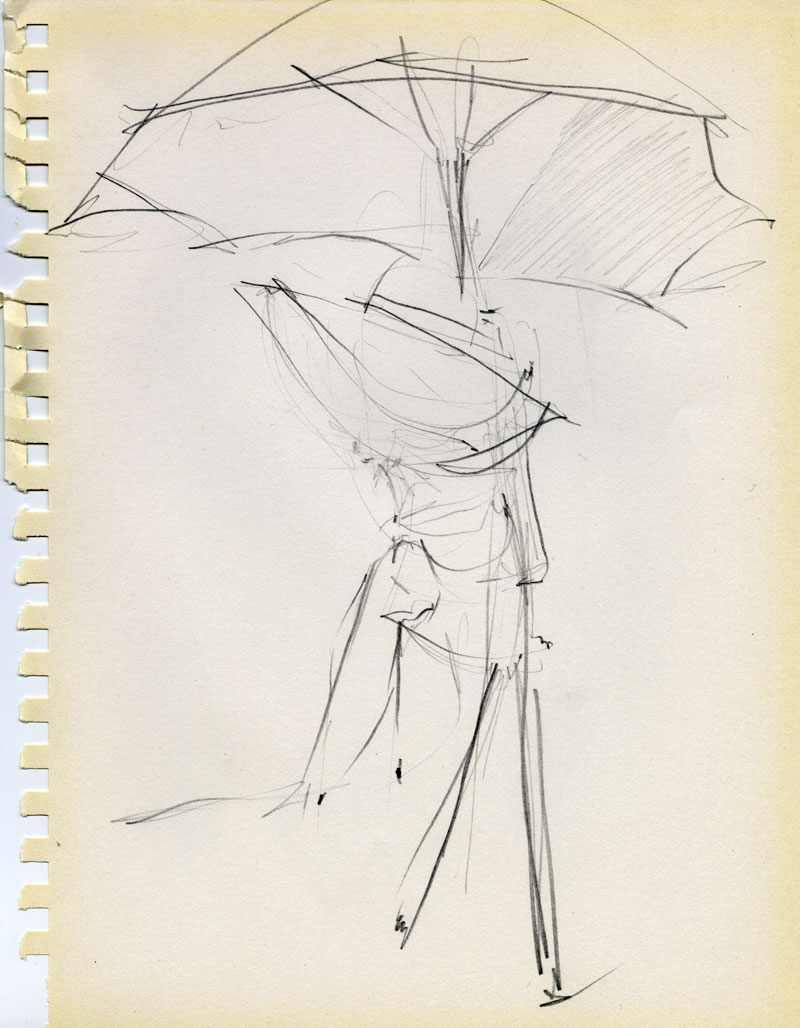
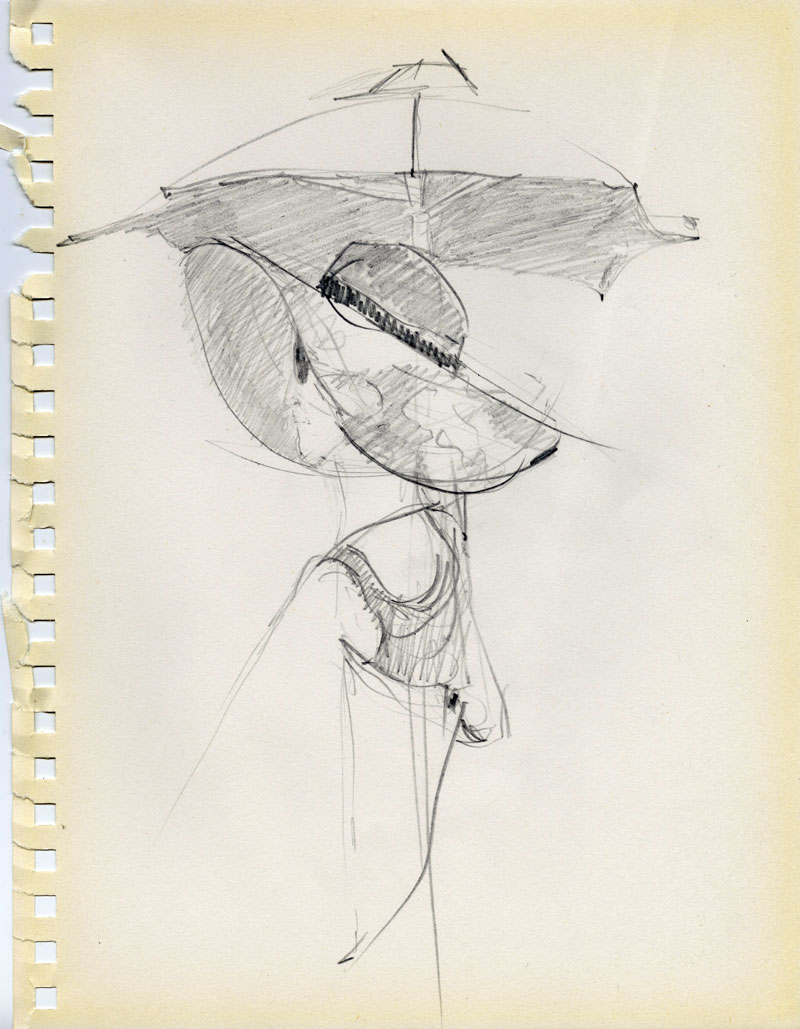
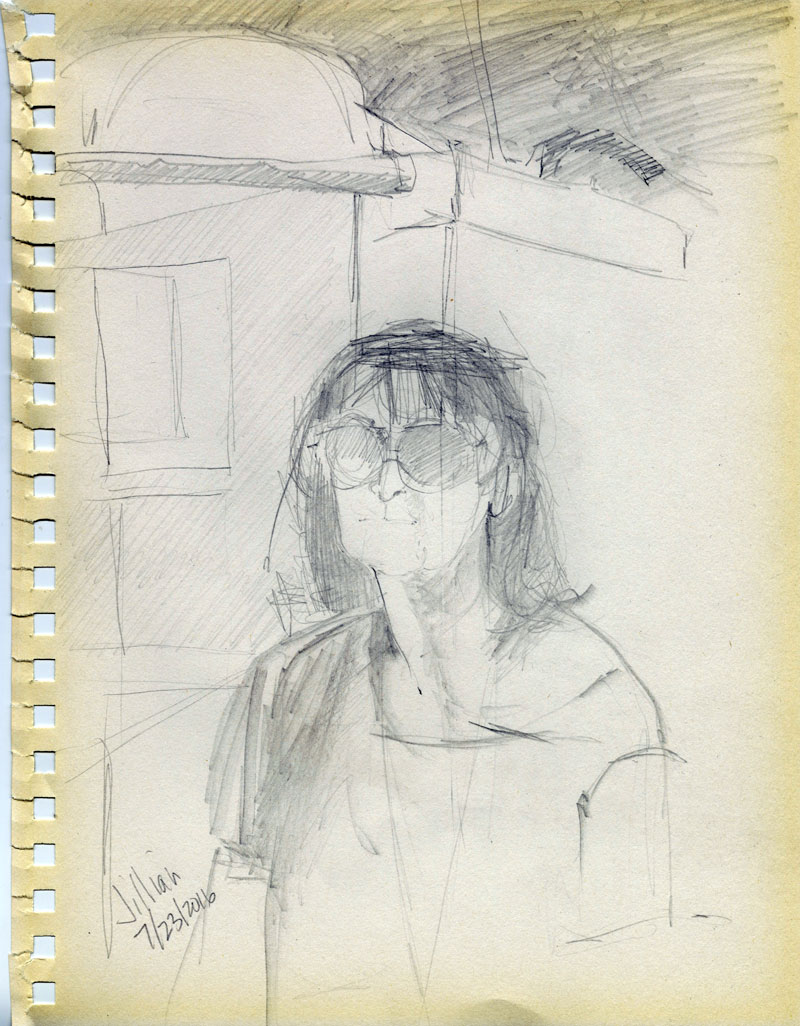
Karin Wagner Coron is a native of Michigan and a Great Lakes Region artist. She earned a Bachelor of Fine Arts degree from Eastern Michigan University in drawing and painting, which launched her career as an artist and arts business owner. She is a member of the WSG Gallery, and owner/operator of Format Framing and Gallery. You'll find some of Karin's works in AADL's circulating art print collection.
Pulp Staffers' 2016 Art Fair Picks
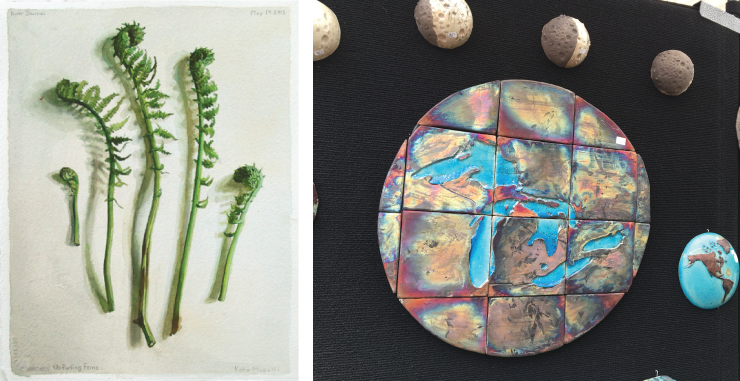
Have you guys ever noticed that Art Fair is HUGE? Or that it's unbearably hot (not just this year, but somehow every year)? It can make it pretty difficult to hit all of the thousands of booths that are set up to find the best of the best. This year, Pulp staffers decided to help by heading out on opening day and finding our favorites. These artists are all definitely worth checking out, whether you are looking to buy or looking to look.
Stan H. Baker
Stan H. Baker, ceramic artist from Ann Arbor, was set up on Main Street selling his map plates and wall globes. The wonderful details of the wall-mounted half moons caught my attention – each one depicts a different phase of the moon. What drew me in further was when I realized that he is masterfully using the raku firing technique for the purpose of depicting the dark portion of the moon. He is also able to get beautiful iridescent glaze effects. I’m a big fan of maps and his didn’t disappoint. -Anne
Jen Callahan, Coastal Colors
Jen Callahan is a Florida-based artist whose artwork looks like a paint-aisle explosion in the best way possible. Her artwork features beachy, seaside settings and underwater creatures, made all the more enchanting by her vibrant color palette that seems to include everything from tranquil blues and purples to luminous greens and pinks. If you've never seen a rainbow-coated jellyfish or a sea turtle painted like a stained-glass window, it's definitely time to upgrade your life. -Nicole
D & M Wooden Flowers
D & M is local, based out of Saline, and their brilliantly-colored wooden flowers are some of the most impressive wood carvings I have ever seen. Their basswood lilies, tulips, and daffodils are painted in sunny colors that render them bright, detailed, and so realistic that I almost can't remember why I bother to buy real flowers when I could be buying breathtaking wooden daises that my cats can't destroy and eat. -Nicole
ISMS - Holly Ulm
Minnesota-native Holly Ulm drew my eye through the natural colors of her incredibly delicate-looking butterfly jewelry and art prints. Her art is offbeat and whimsical, featuring things like a black and white cat with brightly-colored Monarch wings or a mermaid with a tail that changes smoothly into the wings of a moth. All of Ulm's art uses the wings of real butterflies who have completed their life cycles and died of natural causes at butterfly conservation farms. Ulm then uses what I can only imagine is a 100-bajillion-step process to preserve the wings in as close to their natural state as possible--and she does a beautiful job. Each piece of jewelry is gorgeous and every art print manages to incorporate the wings in a way that lets their natural beauty speak for itself. -Nicole
Katydids Kritters
Katydids Kritters is another local artist who makes art of the 3-dimensional variety. Her adorable hand-sewn wares are not only decorative, but functional! Owl-shaped doorstops, little critter sleep masks, and hot and cold therapy plushies that can be used on sore muscles and other pains. Because how could you possible still feel bad with an adorable stuffed penguin hanging out on your sore knee? You can't, that's how. -Nicole
Katie Musolff
When looking through booths I might take a closer look at before going out (you've got to make a plan on these 95 degree days), Katie Musolff's work didn't make my list. Interesting photographs, but that's not really my thing. But this is because thumbnails don't do her work justice. Those plants and animals, all apparently photographed from above in museum cases or on kitchen tables, aren't photographs at all but exquisitely rendered gouache paintings. They are done with such skill that they appear at a distance to be the real thing, but this is not photorealism or trompe-l'oeil. Musolff has simply mastered her tools so well that her paintings communicate all the essence and form of her natural subjects. Mushrooms pop off the page and fiddlehead ferns are in their brightest April green. Musolff conveys the life of these items, freshly ripped out of the ground for their moment of immortality. As you look, you can almost smell them.
-Andrew
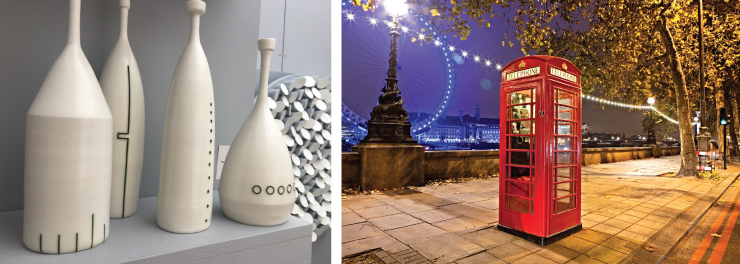
Michelina Risbeck
Michelina Risbeck is a University of Michigan student. She creates mixed media works using household paint and joint compound on Plexiglass that explore the interplay of texture and color. Often reminding me of landscapes or abstract renditions of microscopic biological processes--like the division of cells--or the chaos that was the beginning of the universe. One of the artists I was totally blown away by in the Street Art Fair's New Art, New Artists (NANA) booth, selected to participate in this one-on-one mentoring program and are exhibiting for the first time at the Art Fair.-Anne
Chris Rom & Geoff Buddie
Ohio husband and wife team Chris Rom and Geoff Buddie are back for their ninth Ann Arbor Art Fair. Their work is a collaborative effort; they use porcelain, wood, fiber, and mixed media to create elegant minimalistic works. Repetition of shape creates visual interest and the hint of sequence. Their work ranges from familiar objects, such as bottles made of porcelain with a clear glaze and minimal black line decoration, to larger more abstract wall installations made up of repeating geometric 3D shapes. Intricate shadows add to the overall composition, which changes with the angle of light or the viewer’s angle of perspective. There is an order to their work that evokes a sense of calm. Though neither Chris nor Geoff would admit to an overtly mathematical background, they did mention that there is at least one engineer in their family. An earlier work of theirs is on permanent display at the Downtown Library (first floor near the new books). -Anne
Christine Schub
Christine Schub has been showing at the Street Art Fair for about 20 years now, and there's a reason why she is a staple. Her work never disappoints in its intricacy and liveliness. Strictly nonrepresentational, her paintings lead the viewer to imprint their own loves on them; I see city buses, building facades, aerial views of landscapes, and geological layers, all dancing around each other. She says that hearing what people see is one of the most enjoyable parts of being a painter and coming to the Fair. There are certainly echoes of Mondrian before he went full-on neoplasticist, but you won't find any rigidly straight lines here. These paintings almost appear ready to drip right off the canvas, and it's that life and presence that has made Schub's work worth checking out all of these years. -Andrew
Kyle Spears
I was drawn to the red phone box sitting like a Tardis at the center of Kyle Spears’ “London, England” color photograph. A string of white lights runs behind it and down the receding sidewalk, while further beyond lies the London Eye and the Houses of Parliament lit in bright blue. Other prints in Spears’s booth are similarly alive with color, light, and contrasting edges or textures, an effect enhanced through long exposure using a medium format film camera and a combination of traditional and digital printing techniques. A couple black and white photographs focus on what Spears calls “moments of beauty amid chaos”: In “Notions of Time, Paris, France,” an odd-shaped corner building and striped crosswalk precede a curved alley and a ghostly time-lapsed figure; in “Fragile, Tokyo, Japan,” a jumble of squares, rectangles, and lines define the back of a building complex while simultaneously framing a woman’s face on a billboard. Spears not only shows us the world we see, he shows us the world as we’d want to see it. -Amy
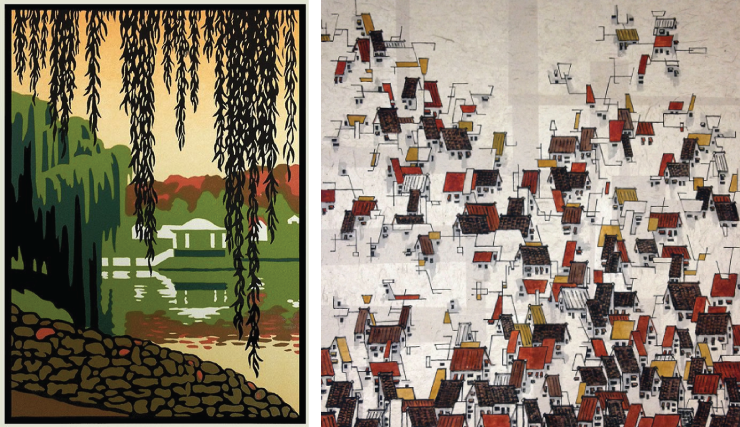 Impermanence #713 by Nha Vuu.">
Impermanence #713 by Nha Vuu.">
Nha Vuu
Nha Vuu had a few different things on offer, including some beautiful, large-scale renderings of flowers and other plants that evoke traditional Chinese paintings, but the things that drew me in were the rooftops. Vuu has a number of large works that depict the roofs of crowded residential areas, just lines of ink applied with a brush that hint at actual structures, occasionally with a splash of color, all on handmade paper. These remind one a bit of those same traditional Chinese paintings, but also of Cezanne's Provencal landscapes, Russian Constructivism, and Richard Thompson's Cul de Sac. In the smaller works, the rooftops dissolve into unrecognizable abstractions, easy to take as being not at all representational, simply a pleasing arrangement of lines and shapes. Each of the works shows a mastery of composition, whitespace, and the daringness to eschew all but a very limited palette, used in a very limited way. The alleys and backstreets between these houses are ones you'll want to explore up close. -Andrew
Christopher Wheeler
The best art is almost never the same piece at two feet away that it was at twenty. Christopher Wheeler's mixed media pieces fit this bill very nicely, changing as you approach, inviting you to come in closer, and then requiring that you back up again to take it all in. As you pass by the booth, his large pieces seem to just be paintings: flattened, geometric representations of trees and building facades. Lovely, but sterile in a midcentury modern sort of a way. But upon closer inspection, you find that those flattened shapes are not flat at all but made up of small pieces of paper, painted and then applied to make up a color area with subtle texture. Each of the birch limbs is a Matisse-like cutout, lightly painted in a way that, as you back up, makes you marvel that four cuts with scissors and one pass with a brush can give such a perfect illusion. It all combines to create works that draw you in to inspect, then pull back out to look at the whole again, then zoom in on another aspect. If you buy one, be sure to place it where people can look at it up close and where the light can show off those beautiful textural variations.
-Andrew
Jack White
Retired engineer Jack White’s photography is sharp and full of wonderful contrasts. Though he’s from Pinckney, MI, his Rocks and Roots series was shot in New England. Tree roots and granite form a symbiotic relationship as they become entangled over time. Jack has an eye for framing the perfect shot and capturing just the right moment when the light hits it just so. Most of his photographs are black and white, but if you look closely you’ll catch a hint of color (added by hand) in some. Another of the artists I was totally blown away by in the Street Art Fair's New Art, New Artists (NANA) booth-Anne
Laura Wilder
I'm a sucker for block printing so as I was exploring the S. University Fair I was drawn to Laura Wilder's booth immediately. The intensity of the colors, contrast, and the use of negative space are magnetic in block printing. Wilder's work pulls you in and a close inspection is required. I was drawn initially to her depictions of nature, seasons, ferns, and other flora. I particularly liked her block print entitled Hiawatha Lake because she uses the willow trees to softly frame the structure in the background. Once in her booth I was equally drawn to her whimsical and lovely serigraph, The Scottie, just one of her many dog breed pieces. Wilder's Seasons IV, a four-season woods/stream framed piece would make a dramatic and soothing addition to a room. The panoramic layout, the use of color and the intensity of the work evoke the movement and shadows in nature. My favorite pieces were traditional block prints. Wilder describes the process: usually created with wood or linoleum blocks; non-image area is cut away, leaving only the image surface raised above non-printing areas. The ink is usually applied with rollers; may be printed with a press, a baren, a rolling pin, or a wooden spoon. Wilder offered her work in lush wood frames as well as limited edition giclees, note cards, mini-prints, posters, and more. Wilder is from Rochester, NY, and some of her work is off landmarks and popular spots in that region. -Erin
Nick Wroblewski
Printmaker Nick Wroblewski’s woodblock prints are breathtaking. Obviously he is inspired by the Japanese woodblock tradition, but his subjects and colors are unmistakably North American. Beautiful forest scenes, wetlands, and birds are all masterfully recreated. He uses the reduction printing method where a multi-color print is created using only one block by cutting away more and more of the surface in-between each color printing. The block is ultimately destroyed as each new color is carved. He has an example of the carved blocks on display to illustrate the process. Definitely worth a look. -Anne
Pulp staffers declined to write about their real Art Fair Picks: water bottles, t-shirts, umbrellas, and shady trees.
The 2016 Ann Arbor Art Fair will continue through Sunday, July 24, 2016.
Preview: David Liebe Hart on Aliens, Songwriting, and ASCAP

Musician, actor, artist, and alien abductee David Liebe Hart is hardly the kind of person one might expect to have a national fan base. The Los Angeles-based Hart is best known for his simplistic but catchy songs about extraterrestrials, social issues and his personal life, delivered in a vigorous but occasionally cracked singing voice, often with a well-worn and deranged-looking puppet by his side. Hart, who was raised a Christian Scientist, originally developed a cult following in the '90s with his Los Angeles public access TV show The Junior Christian Teaching Bible Lesson Program. But Hart's real break came in 2007, when comedians Tim Heidecker and Eric Wareheim recruited him for a number of segments on their cheerfully disturbed Adult Swim program Tim and Eric Awesome Show, Great Job! A segment featuring Hart's song Salame, named after an alien greeting Hart says he learned when he was abducted in 1988 by an extraterrestrial race known as the Korendians, proved particularly popular.
This summer Hart will release an album by Chip the Black Boy, one of his better-known puppet characters. He's also in the midst of an extensive national tour, which promises "Music! Puppets! Videos! Laughs!" and will stop at Ypsi's Crossroads Pub July 21. In advance of the Ypsi date, I chatted with Hart about the challenges of touring life, his recent troubles at an American Society of Composers, Authors and Publishers (ASCAP) meeting and, of course, aliens.
The following has been edited for length.
Q: So what should we expect of your show when you come play in Ypsi? It sounds like there's going to be a lot going on.
A: I'm going to have an opening with some Adult Swim people that I work with. Tennessee Luke is doing the opening of the show with Scott Palmer. Tennessee Luke plays an alien and Scott Palmer plays a news announcer. They're doing a comedy about two aliens that are fighting with each other. I won't give out the end. I want it to be a surprise, the rest of the stuff. I'll be doing UFO songs I wrote and songs about ex-girlfriends and I'll be doing a little bit of standup comedy with two favorite comedians that I admire. We're going to give people a good show.
Q: You've talked about how you had to make your living busking in the past despite your TV appearances...
A: Yeah, but the sad situation is we're losing our freedom of speech in America. I paid $480 for a [street performer's] license and the city [of Santa Monica, Calif.] says you have to find the permit over again. If you can't find it you're going to have to pay $400 for it all over again, which really stinks. I've been buying a permit for over 30 years.
Q: It sounds like you've had a tough time, but you've also got a lot of tour dates scheduled right now. Is that a good sign for you?
A: [Manager Jonah Mociun] has got me piled up pretty tough right now. I told him this time I have to have my half of the money to pay the bills. Before I left, the public storage and the landlady says that if you don't pay the rent on the first it's a $60 late fee. On the second day, on the third, it's a $100 late fee. On the fourth, it's a $150 late fee. I didn't want to pay all those late fees, so I had to pay my rent before I left for two months because Jonah tells me now I'm not coming back until the third. I thought I was coming back on the second and I had my mail held until the second. What's going to happen if I don't email the post office? They're just going to put the mail on top of the mailbox. Anybody can help themselves to it. The people who work for the post office in Los Angeles don't speak English. It's a big mess.
Q: You've got a forthcoming Chip the Black Boy album. What can you tell me about that project?
A: Well, Chip is going to be singing a horror song about that he's dead and he's coming back from the dead to haunt people and haunt things. There's some cool rapping music on there, a rap song about not smoking glue and teaching kids to be positive and stay away from negative things like drugs. Jonah's done a lot of the hard work with my music. He's very talented. He's growing a beard. He looks terrible. He needs to keep his youth and stay young as much as he can. His girlfriend doesn't like it either. It's freaking me out and freaking other people out.
Q: So to go back to Chip for a second, you describe Chip as your son. What can you tell me about him and the relationship between you two?
A: Well, Chip reminded me of my dad. I was like Chip growing up as a child and my dad was a schoolteacher who was teaching me right from wrong. I was rebellious and that's what inspired me to write the song Father and Son. I wrote all the songs I performed on Tim and Eric Awesome Show, Great Job! I'm an ASCAP writer and publisher. But I was disappointed that Tim and Eric won't let me use the songs, as well as Warner Bros., and then I haven't gotten paid for any of the songs I wrote for Tim and Eric. I'm grateful for all the fame and success Tim and Eric have given me, but like the Bible says, the laborer is worthy of his hire.
Q: So what is your relationship with those guys like these days?
A: Well, I still get along with them and I'm still working with them. I did Decker: Classified last year and this year, but was disappointed that they cut off all my parts that were supposed to be in season one.
Q: I want to ask you a few questions about your song Go Into the Light. You've said that the Korendians were not pleased with you sharing the word "salame" in your song of the same name. Why did you decide to share more Korendian sayings in Go Into the Light?
A: Jonah said, "Well, no, the aliens are not going to be pissed off about you using their name." And Elder Master Latan, which is one of their commanders, says that they wanted to keep secret what they were doing because they've given a lot of back-engineered technology to our government and other countries. They just want to be secretive. They're also at war with another race called the Omegans that they've had a 200-year war with for space territory. The places where the Korendians used to meet me and contact me mostly was at La Brea Tar Pits, but I've been 86ed from there. So I haven't been there in almost a year. It's kind of frustrating. They used to speak through my TV and they used to appear in my apartment like a Bewitched episode and a Dark Shadows or I Dream of Jeannie show. They used to appear out of nowhere when I was walking or when I was sitting by myself. The last ones to contact me were the Omegans, and now they don't contact me anymore either.
Q: Have you ever encountered others who have come in contact with the Korendians?
A: The Palladians that live under Mt. Helen and Mt. Rainier in northern California contacted me and said that they had been teaching the Korendians meditation, that they were the ones who taught the Korendians to be vegans and vegetarians and to be a more peaceful race. They work a lot with the Palladian race. The Palladians were responsible for bringing blond hair to the Caucasian race.
Q: Why do you think so many different alien races have reached out to you in particular?
A: People don't understand. It's like, why do cactus grow in the desert and not in a lake like a water lily? There has to be a chemistry, just like a relationship. A girl that you meet and you want to date, there has to be a chemistry between both of you. You have to be in their frequency. If you're not in their frequency, they're not going to contact you. If you have one bit of fear and doubt that they don't exist, or they're make-believe, with the brainwashing that 99 percent of Americans have you'll never experience it. It's like I tell a lot of people. I say, "Well, a lot of people don't believe in elephants or zebras or horses just because they've never been in a zoo to see them or seen them on TV." So you've got people that are just doubting Thomases. They don't see something, they don't believe in it. They're brainwashed not to believe anything that they don't understand or they haven't seen, but that doesn't mean they don't exist. You've got society that's got people brainwashed against different things. It's very sad. Someone else is calling me. Can I tell them to call me back, whoever they are?
Q: Oh, sure.
A: Hello? Are you back on the line? Hello? Hello?
Q: Yes, I'm here.
A: Yeah, I was supposed to also get a call from the unemployment office, since I worked for Tim and Eric, to get an extension on my unemployment. So I've got to talk with them about that. They're supposed to call me any day about that. What happened to me at the ASCAP meeting was pretty lame.
Q: What happened?
A: I had a Bernie Sanders button on and the people that were ASCAP members didn't like it. They say, "We want only people that are Republican to come to the ASCAP meeting to vote, not people that are Democrat or are liberal or are for peace and freedom." So then they had these three huge Hispanic security guards follow me wherever I went and they said, "They don't want you in this ASCAP meeting. Since you're voting for Bernie Sanders, they want you to join [Broadcast Music, Inc.]" Next thing I knew, three Hispanic security guards knocked me to the ground, handcuffed me like I was a criminal, like I'd done something wrong, and escorted me off down to the Starbucks. Some people saw it. Some people drove me to the police department about it and [ASCAP president] Paul Williams was contacted. ASCAP did not contact me with an apology or anything, or anybody with an apology. It made ASCAP look bad. I won't be going to the ASCAP meeting ever again after what I experienced, not unless I get an apology from Paul Williams.
Q: Speaking of your songwriting, what is your songwriting process like? What instrument do you usually start writing a song on?
A: I started writing religious music. I was a church pianist for the Christian Science Sunday School. Kathy Case, Mrs. Volk and Miss Waller taught me how to. They were all pianists and organists for the Christian Science Sunday School and church services, and they taught me how to play the difficult Christian Science hymns from the 1932 hymnal. Their hymns were very boring with classical music. They just renewed two supplements and Dorothy Estes, who put the new Christian Science supplement together, said they didn't want any music with ethnic tones to it, by ethnic people. It's very racist. I love Christian Science, but I don't like the racist, biased people that run the church. So all of my hymns were refused from the two supplements that the Christian Science Hymnal put out. Then, another thing: I've been taking all my CDs around the different nightclubs I play at. I only have 10 packages, but I'm hoping and encouraging them to play the songs so I can get paid and Jonah can get paid more royalties from ASCAP. We took them around to the college radio stations, but my royalty check was $1.97. I don't know what his was, but he feels it's a waste of time. He says I don't have time to pass out the stuff for the first three concerts because he has a lot of driving to do. So I try to pass out my sheet music and give them a website where they can hear the songs online. He says I won't have time to do it for the next three concerts, which is very frustrating.
Q: So when you're on tour, what's your sense of how your audiences respond to you and your music?
A: Oh, they love the stuff. They love it. They enjoy the music and they compliment. I wish my gospel albums, my religious albums, would start selling. Jonah says the gospel albums only sell once or twice a year, which is frustrating. [To someone else:] Thank you.
Q: Why do you think people are less interested in the gospel music?
A: I don't know. I really don't know. [Begins chewing food.] The last three concerts I haven't even brought the gospel music with me. I only bring the punk rock albums, the stuff that young people want.
Q: Do people ever come to your shows who don't seem to take you and your music seriously?
A: There's some doubting Thomases, one or three. They're old, conservative people. They're old enough to be your parents. They're racists and biased. Forget them.
Q: If you were to have people take away one thing from seeing you live, what would it be? If there's one thing you want people to get and understand?
A: [Still chewing.] That UFOs are real and people don't understand that relationships can't always be what we want them to be. I was dumped by several girls that I loved very much, but you have to move on. That's what you have to do.
Patrick Dunn is an Ann Arbor-based freelance writer whose work appears regularly in Pulp, the Detroit News, the Ann Arbor Observer, and other local publications. He has yet to be contacted by any alien race.
David Liebe Hart brings his puppets and songs to Crossroads Pub in Ypsilanti on Thursday, July 21. Tickets are $10 in advance, or $15 at the door. Doors are at 7pm and the show is 18+ Opening acts include Pineapple Army, Daughters of Eternity, crochetcatpause, The Landmarks and Lips.


































